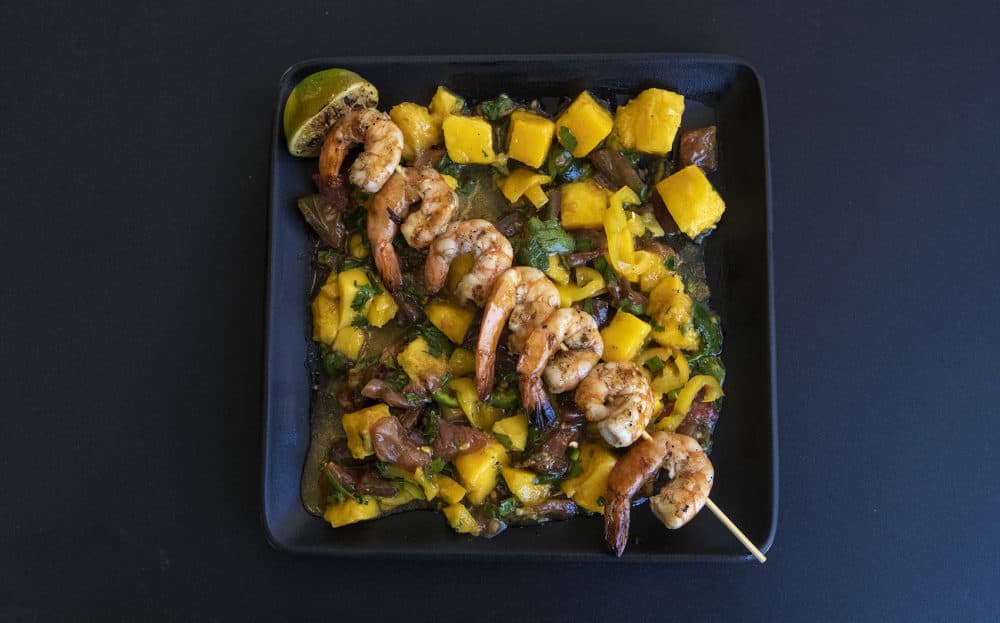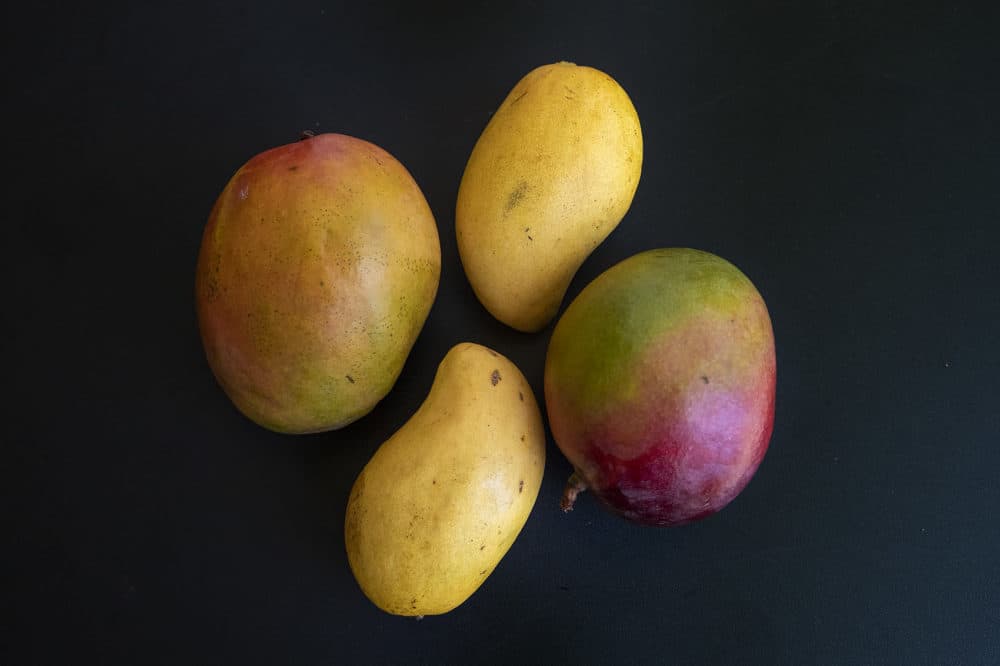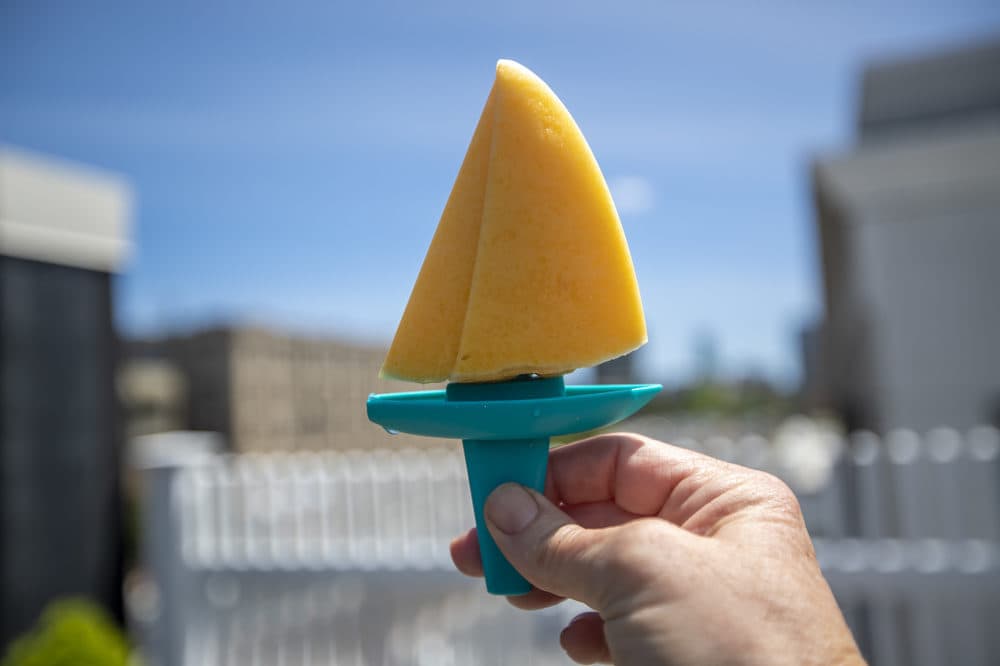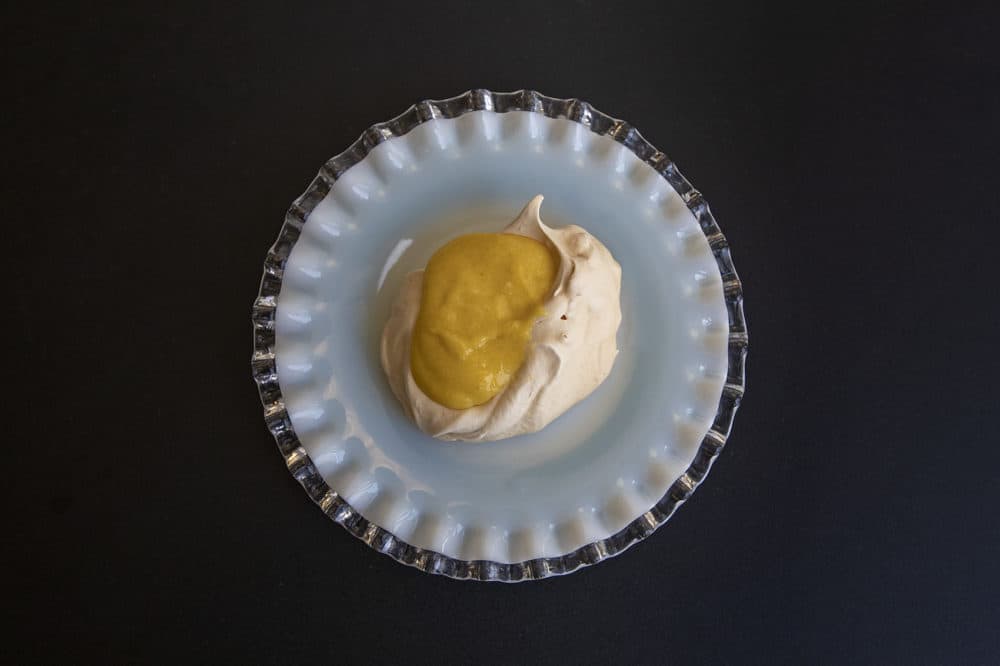Advertisement
Making The Most Of Mangoes With 3 Tasty Summer Dishes
Resume
Mangoes are a beloved fruit in much of the world. Native to South Asia, they belong to the cashew family. You'll find mangoes that are green, yellow, orange and red, with smooth skin or thick leathery skin. The flesh is moist, rich, juicy and sweet.
They grow all year around the world but, for the most part, summer is mango season. Look for them in markets and try to taste a variety of mangoes to fully appreciate the nuance and range of colors, flavors and textures. They can be eaten raw, used in salads, chutneys and salsa or grilled, fried, sautéed or roasted.
Mangoes are loaded with vitamin A and C, fiber and potassium. And one mango is around 135 calories.
Types Of Mangoes To Try
Florida grows much of the mango crop in the U.S. but there are many varieties to explore and all are worth looking for. Some of the more popular varieties often accessible in the U.S. include:
- Alphonso (also Hafoos, Hapuz, or Aapoos) are prized for their flavor, aroma and taste, grown in India and difficult (often impossible) to find in the U.S. Many consider their sweet flavor to be the best of all mangoes. A rich marigold color, with little or no stringy fibers, those who know the Alphonso will travel to far-off parts of the world to find them. According to Myles Karp, writing for Vice, Alphonso mangoes are highly sought after: "Whenever these mangoes hit the United States, whether [the shipment is] arriving in Newark or whether it's arriving in some other major airport, the word spreads like wildfire, and the mangoes are gone within a day."
- Ataulfo are often referred to as the “champagne mango." They are smooth, with a little fibrous texture found in so many other varieties. When ripe, they will be soft to the touch — and possibly even wrinkled. The fruit will have a velvety, creamy texture and a sweet mango taste. Ataulfo are small and oval in shape and are primarily grown in Mexico from March through July.
- Francis mangoes are cultivated in small farms all over Haiti and have an almost spicy, tangy and sweet taste. The flesh has fibers but is very soft and juicy. They are available from May to July. Francis mangoes are bright yellow in color with green overtones and turn green-golden yellow when ripe. This mango is a great choice for chutneys and cooked dishes.
- Haden are rich, with aromatic, almost lemony overtones, making them an excellent choice for use in cooking or for eating raw. Haden mangoes have a firm flesh with fine fibers, making it not-so-stringy and off putting like other more fibrous varieties. Haden mangoes are large, bright red in color with green and yellow overtones and small white dots. This kind of mango has a medium to large oval-round shape. They are primarily available throughout April and May. Haden's roots can be found in South Florida, where it was first planted in 1910, giving birth to the mango industry in the area.
- Honey mangoes are sweet, creamy-fleshed with a small seed and smooth, firm vibrant yellow skin and almost no fiber. The skin wrinkles when the mango is ripe.
- Keitt are grown in Mexico and the U.S. and are an ideal mango to eat green — or use for a green mango salad — as they have a naturally sweet and tart flavor, unlike other mangoes, which can be very tart or even bitter if too green. When ripe, it can be pickled or used in curries. Keitt mangoes are dark to medium green with a pink blush, and have a sweet and fruity flavor with firm, juicy flesh having only a limited amount of fibers. They tend to be large and oval in shape. These are available in August and September.
- Kent mangoes are large and plump, with a dark green and dark red blush and a buttery, juicy, almost lime-like flavor. Kent are favored for baking, and also make a great choice for drying. The fruit itself is large and oval in shape. Available from January to March and June to August, the Kent mango is largely produced in Mexico, Ecuador and Peru, but they originated in Florida in the 1940s.
- Palmer are another Florida variety from the 1940s. A smooth flesh mango with limited fibers, they are large — around 1 1/4 pounds — with a rosy speckled yellow skin. Some say the fruit has an apricot-like flavor.
- Tommy Atkins are one of the best known, most widely grown mangoes in the U.S. Grown in Florida, they are mildly sweet, the flesh is firm, and in season from March through July and then again in September and October. This is a large — often 1 pound — mango with a thick skin, dark red blush and yellow flesh. Some find the flavor bland and fibrous, but others swear by this Florida favorite.
- Valencia Pride mangoes are an offshoot of the Haden mango and also originate in Florida. A large fruit with a red and yellow blush skin, Valencia Pride is a fiberless variety and has a smooth, melting, juicy texture. It is available July and August.
- Van Dyke mangoes originated in the 1940s in Miami and are smaller with a yellow, red and orange skin and yellowish orange flesh. They have a mild aroma and a rich, almost spicy sweet flavor.
More About Mangoes

How To Know When A Mango Is Ripe
Squeeze the mango gently; if it's ripe it will have a slight give. Think of the way you test an avocado or peach: a gentle push is all you need. Don't focus on color. Since mangoes come in all colors, looking for red or orange is not the best way to tell if a mango is ripe.
How To Cut A Mango
Many people avoid eating mangoes because they are intimidated by the big pit in the center and have no idea how to cut the flesh out around the pit.
Mangoes have one long, flat seed in the center of the fruit. Place the mango upright on a cutting board and using a sharp knife, cut down one side of the mango working close to the pit. Repeat on the other side of the pit. Take one of the pieces you cut from the side and cut a large tic-tac-toe like pattern in the flesh. Working from the skin side, push the mango squares out of the skin and eat or cook. Repeat with the other half.
You can cut off any remaining fruit from the sides of the pit.
Mango Salsa With Grilled Shrimp
Ripe mangoes make juicy sweet salsa that has a beautiful color, texture and taste. Mix with tomatoes, chili peppers, lime juice and cilantro and serve the salsa with grilled shrimp or raw vegetables. You can also spoon it over any type of fish or grilled meat or chicken.
Serves 2 to 4.
The Shrimp
- 1 pound medium shrimp, peeled except for the tail and deveined
- 2 tablespoons lime juice
- 1 tablespoon olive oil
- Salt and pepper
The Salsa
- 2 cups mango cubes
- 1 cup ripe tomato, chopped
- 1/4 cup chopped cilantro
- 1 small sweet yellow pepper, chopped seeds
- 1 tablespoon chopped deseeded jalapeño (keep a few seeds if you like a spicy salsa)
- Juice 1 large lime
- Salt and freshly ground black pepper
- 2 tablespoons olive oil
- Hot pepper sauce to taste
Instructions
- Heat a charcoal or gas grill until hot, about 400 degrees. Place a vegetable rack on the fire. Place the shrimp on skewers and brush with the lime juice, oil, salt and pepper.
- Make the mango salsa: mix all the ingredients and taste for seasoning adding more salt, pepper and hot sauce if needed.
- Grill about 3 minutes per side, or until pink and firm.
- Place the salsa in a large bowl and place the shrimp skewer on top.
Mango-Yogurt Popsicles

Three ingredients are transformed when pureed and frozen. Refreshing and light is how I’d describe these popsicles.
Serves 4.
Ingredients
- 1 1/4 cups chopped fresh mango (about 1 large mango)
- 1/3 cup plain yogurt
- 1 1/2 teaspoons lime juice
- 1 tablespoon honey (optional)
Instructions
- Place the mango, yogurt and lime juice in a blender or food processor and puree.
- Add the honey if the mango is not particularly sweet.
- Place in 4 popsicle molds and freeze for at least 2 hours or until frozen solid.
Meringue Cookies With Mango-Lime-Orange Curd

If you're making meringues on a humid day, you'll need to keep them in the cooled-off oven all day until serving to avoid the humidity "wilting" the cookie.
Makes 14 large cookies.
The Meringue Cookies
- 3/4 cup sugar
- 4 large egg whites, about 3/4 cup
- 1/8 teaspoon cream of tartar
- Pinch salt
- 1/2 teaspoon vanilla extract
The Filling/Topping
- 1 1/2 cups mango-lime-orange curd (see recipe below)
Instructions
- Heat the oven to 350 degrees.
- Place the sugar on a baking sheet and bake on the middle shelf for 10 minutes.
- Place a parchment paper on two cookie sheets.
- In the bowl of a stand mixer, whip the egg whites and cream of tartar until frothy about 2 minutes. Remove the sugar from the oven and reduce the oven temperature to 200 degrees.
- Very slowly add it to the egg whites bit by bit, whipping the white on high. Add all the sugar and then the pinch of salt and vanilla and beat until the whites hold a stiff peak. When you lift the whisk from the stand mixer, the meringue should appear stiff.
- Using a 1/3 cup measuring cup, make 14 cookies distributed among the two prepared cookie sheets. Using the back of a soup spoon to create a small indentation in the middle of the cookie (this is where the filling will go).
- Bake on the middle and top shelves for 2 hours, switching the cookie sheets after one hour of baking. After two hours turn the oven off and leave the meringues in the oven for another hour.
- To store: keep in the cooked-off oven overnight or store in an airtight container.
- To serve: fill the indentation with a heaping tablespoon of the curd.
Mango-Lime-Orange Curd
Curd is a topping or preserve made from citrus, butter, eggs and sugar. Traditionally it is made from lemons, but I had a ripe mango on hand and a bunch of limes and an orange and thought, "Why not?"
You'll only need half this recipe to fill the cookies, but you won't be the least bit unhappy to have a bunch of this tart-sweet curd leftover. Spread it on morning toast, on top of yogurt with fresh fruit, on top of pound cake, lemon cake, cookies or muffins.
Makes about 2 cups.
Ingredients
- 2 cups mango cubes, from 1 large or 2 medium mangoes
- 1 teaspoon lime zest
- 1/4 cup fresh lime juice
- 1/2 teaspoon orange zest
- 1/4 cup fresh orange juice
- 1/2 cup sugar, plus 2 tablespoons
- 1 teaspoon vanilla extract
- 3 egg yolks
- 1 whole egg
- 1 stick chilled butter, cut into 8 pieces
Instructions
- In a blender or food processor puree the mango, lime zest, lime juice, orange zest and orange juice. Pour the puree into a medium saucepan with the 1/2 cup of sugar and vanilla, and while stirring, simmer for five minutes, being careful not to let the mixture boil. Remove from the heat.
- Meanwhile in a bowl, whisk the egg yolks and whole eggs and remaining 2 tablespoons of sugar. Whisk half the egg mixture into the warm fruit mixture. When fully incorporated, whisk in the remaining egg mixture, place over moderate heat, and whisk constantly until the curd thickens, about 6 to 8 minutes. Be careful not to let the curd boil. When the curd is fully thickened remove from the heat and whisk in the butter, one or two pieces at a time.
- Strain the curd into a medium bowl, stirring it through with a soft spatula. You should have about 3 cups. Place a piece of wax paper or plastic wrap and press it down directly on the curd. Refrigerate for several hours. The curd will keep for about 4 days.
This segment aired on June 20, 2019.
